NAMM 2019 Video: Novation SL MkIII Review and Demo
Novation has just unleashed the latest in its SL range but, really, it’s like no other controller ever before. We discover total control for any studio setup.
UPDATE (25/1): Check out the synth workstation – albeit a smaller, 49-key version – in action in our NAMM 2010 video demo above.
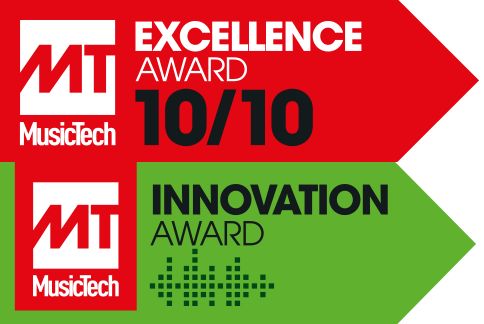
Price £539.99 & £629.99
Contact Novation
SL MkIII key features:
- 61-note controller keyboard, sequencer, arpeggiator
- Keyboard Semi-weighted custom keybed, aftertouch, RGB LEDs above keys
- Pads 16 Pads velocity- and pressure-sensitive, RGB
- Controls 18 encoders/pots, 8 Faders, 16 switch buttons, transport, pitchbend/mod wheel, track/octave
- Sequencer 8 tracks, 8×8 note polyphonic patterns per part
- Connections Clock out, 2 x CV, 2 x Gate, 2 x Mod, Expression, Sustain, Footswitch, 3 x MIDI, USB
Novation’s new SL MkIII is designed to be the perfect partner for whatever type of studio you use. The company is touting it as the ’absolute’ hardware controller which can ’easily integrate hardware with your DAW’, and so it comes with 64 Templates set up in such a way as to control pieces of current and vintage gear. Then there are the extras.
The stand out is an 8-track sequencer derived from the one on Circuit (surely one of the easiest bits of hardware to produce music with) but this can be used to sequence all of that external gear together. There’s a fully-featured arpeggiator, a single Clock to rule all of your studio, plus LED feedback on your keys like NI’s Komplete Kontrol. Top DAW integration includes a focus especially on Ableton Live, although there’s also ’deep integration’ with most others.
Finally, you get all the hardware connections you could need for all the MIDI and modular gear you could own. It’s a controller keyboard, yes, but it’s also like some kind of overseeing school master (keyboard), helping connect your parts, looking after them and getting them all working together. But can it really be all things to all producers?
It’s an SL (slightly)
For a keyboard range to last in excess of a decade is rare in music technology but Novation’s SL range has been with us for the best part of 13 years. The new MkIII on test here bears very little resemblance to those early models but could be as revolutionary as the Automap technology that figured so heavily in its ancestors.
Now that really was revolutionary; controllers that automatically mapped their actions to whatever software – DAW or plug-ins – you loaded up. It was the first serious almost AI-like interaction between hardware and software. And it’s not in SL MkIII. Instead Novation has designed this keyboard from the ground up so that it’s not being restricted by its past, but focusing on the present and the more hardware-orientated studios of today.
There are two models: the 61-note on test here and a 49-note for £539.99. They are not the cheapest controllers but, as Novation says, they come with a lot more than just control. Also, around half-way through my testing, I experienced a ’Eureka’ moment when I realised that maybe you should consider SL MkIII essentially as an eight-part multichannel controller, with an eight-track sequencer thrown in. Suddenly that price doesn’t look so steep…
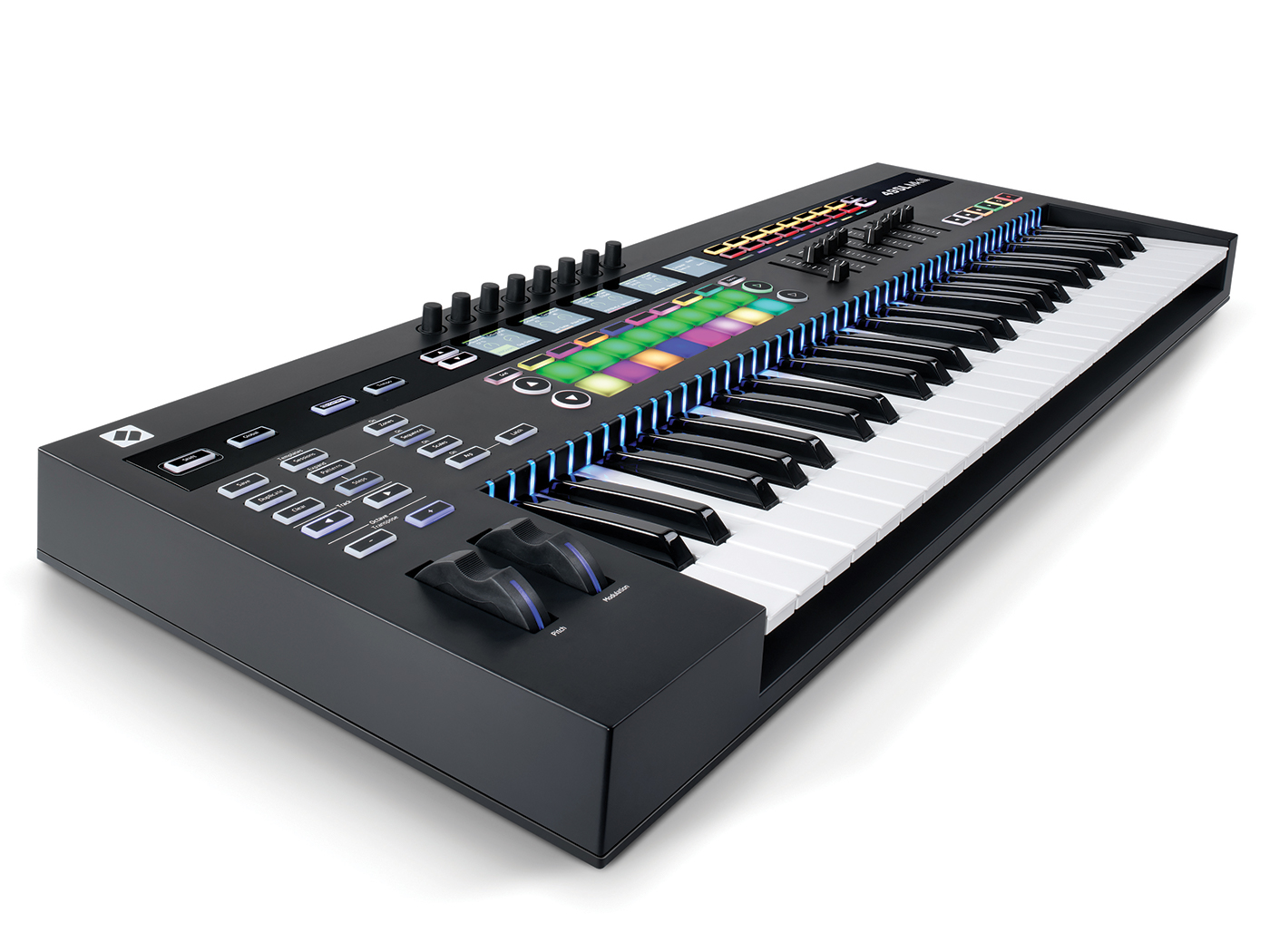
In use
On unboxing, you almost get a feel for where the money has been spent straight away. There is a plethora of buttons, knobs and faders. The keyboard itself feels very well built, the screens and LEDs are lovely, the dials feel solid and the buttons are all responsive. The keyboard itself might disappoint ’proper’ players – it’s a little spongy and flat to me – but you wonder if an 88-note weighted option might be around the corner, as they so often are.
What I absolutely love – and it’s a ’why doesn’t every manufacturer do this?’ moment – is the rubber padding beneath the keyboard, which keeps it firmly in place and protects your work surface. I can’t tell you how many screws beneath keyboards have scratched (OK, not very appropriate) work surfaces on which I have placed them. This thing will sit on your desktop – appropriate or not – and not budge. All other companies take note!
The second thing I love is how stunning SL MkIII looks in operation. The five screens are lovely and work beautifully with the rotaries above; the pads beneath are similar, if not the same, as those used on Circuit so light up in different colours depending on operation (light blue for note on in the Sequencer Mode, Red to delete etc).
The LEDs above the keys – yes, very much a nod to Komplete Kontrol – are also a brilliant addition: white when you hit a note, red if you want to delete one in a sequence; blue in normal operation. Overall, the keyboard is a joy to look at and I almost guarantee you’ll think the same when you power it up. It will slot very nicely indeed into any of the many scenarios it is designed for, just on looks alone.
Now I’ll look at each of SL MkIII’s main parts, the first being external control.
Hardware control
SL MkIII is designed to control via MIDI and CV but, brilliantly, it uses a Template system which includes set-ups for controlling key pieces of gear – Novation’s own synths, naturally, plus a good range including Elektron, DSI, Access, Moog and more. When you select these, the keyboard automatically sets up its rotaries and sliders to control key features and parameters in that hardware.
The KEY POINT here – and I’ve capitalised that to get your attention – is that SL MkIII allows you to access eight of these Template destinations, or parts, at any one time. Press a button here on Destination 1, play a Moog, press 2, tweak a DSI filter, and so on. That means you can also sequence up to eight destinations together, and apply any arpeggiation to different synths, all just by selecting different Templates/parts. Think about that.
Up to eight external pieces of gear all controlled and sequenced from one keyboard simultaneously, but ultimately you can control a lot more simply by changing Templates. And as you’ll see when I discuss the Zones mode, you can also play up to eight different destination Template parts at the same time if you divide the keyboard up into eight parts. This is quite an unheard-of level of control over a complete studio.
In operation, to set each Template up, press Shift and the Sessions button to enter Template Mode to select which piece of hardware each track controls. SLMk II displays also things here like the output destination (MIDI, CV/Gate) and you can change MIDI channels CV channels here.
I happened to have a Roland TR-8S in for testing – the very first Template on my screen, as it turned out – and the rotaries automatically control parameters including tuning, decay and effects, while the sliders control drum part volume levels. It seems a little weird producing drum sequences on one hardware sequencer when the hardware in question has its own sequencer, but what SL MkIII brings to the party is access to that machine’s innards from one place and also access to loads of other gear.
But it’s not just hardware. Connect SL MkIII up to your DAW – via one of the eight Destinations being set to ’MIDI’ – and it will control its soft synths too and truly unite your DAW and hardware worlds.
So this one keyboard can control, automate and sequence each part of a hardware and DAW studio with Templates making the process smooth and automatic. Whether you’re controlling banks of Eurorack gear or specific hard and soft synths and drum machines, SL MkIII can be at the centre of it all, simple as that.
The SL MkIII controlling your studio
1. Controlling external gear
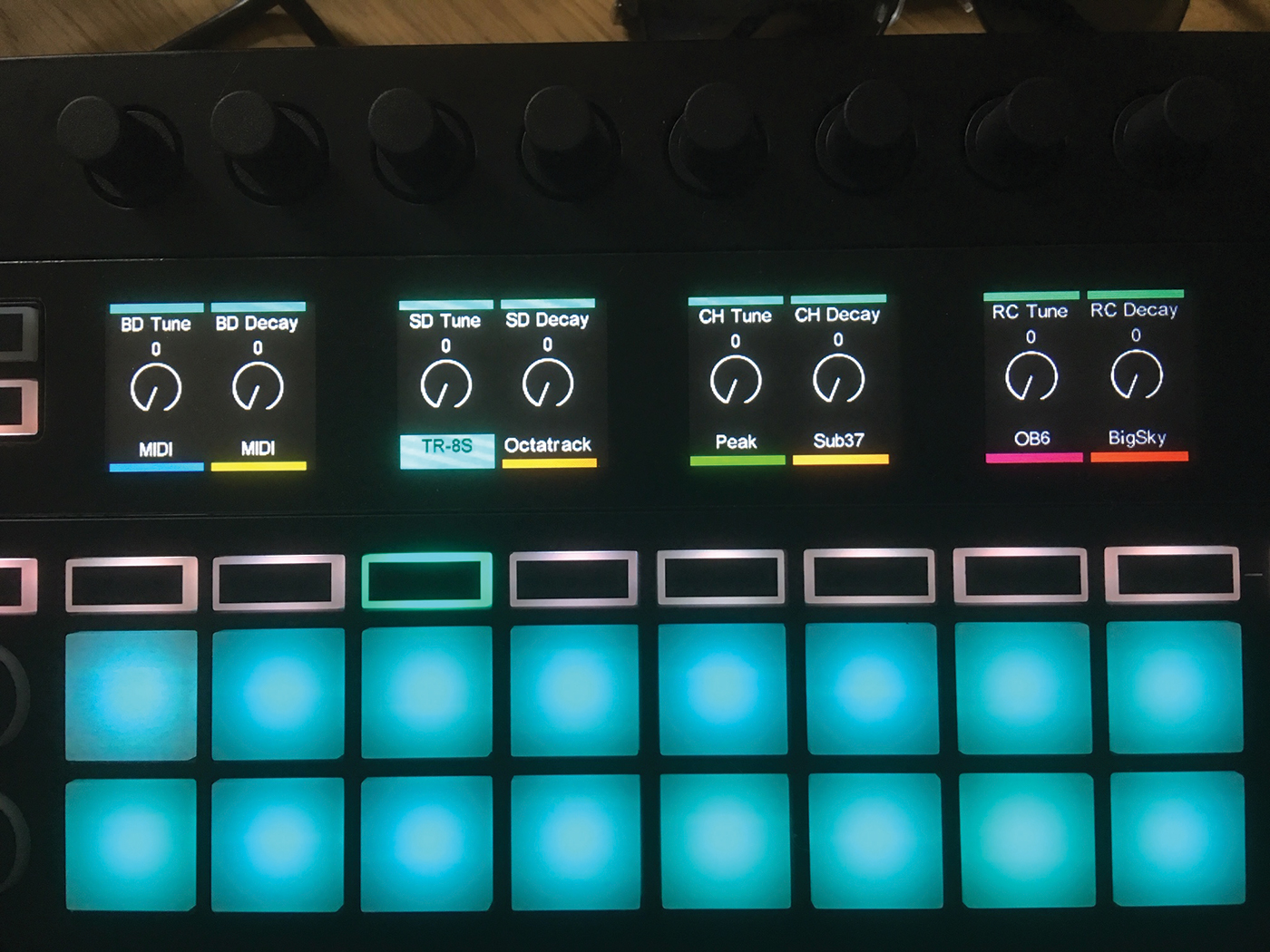
The big draw of SL MkIII is its ability to control and sequence up to eight external destinations via Templates. Think of them as eight tracks if you like.
2. Selecting a template
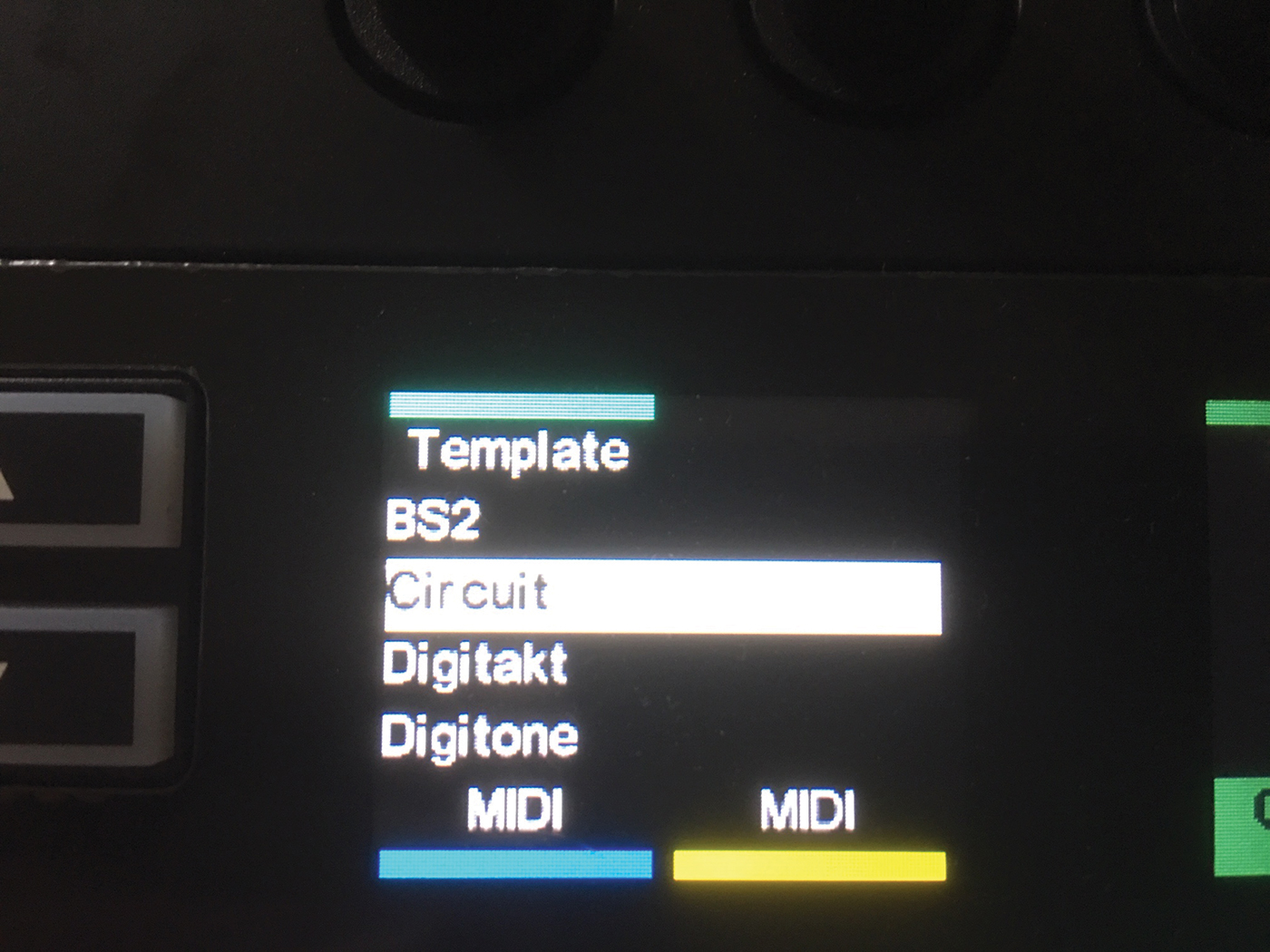
SL MkIII ships with several Templates including Novation’s Circuit which it shares some design features including a similar-style Sequencer.
3. How easy is that?
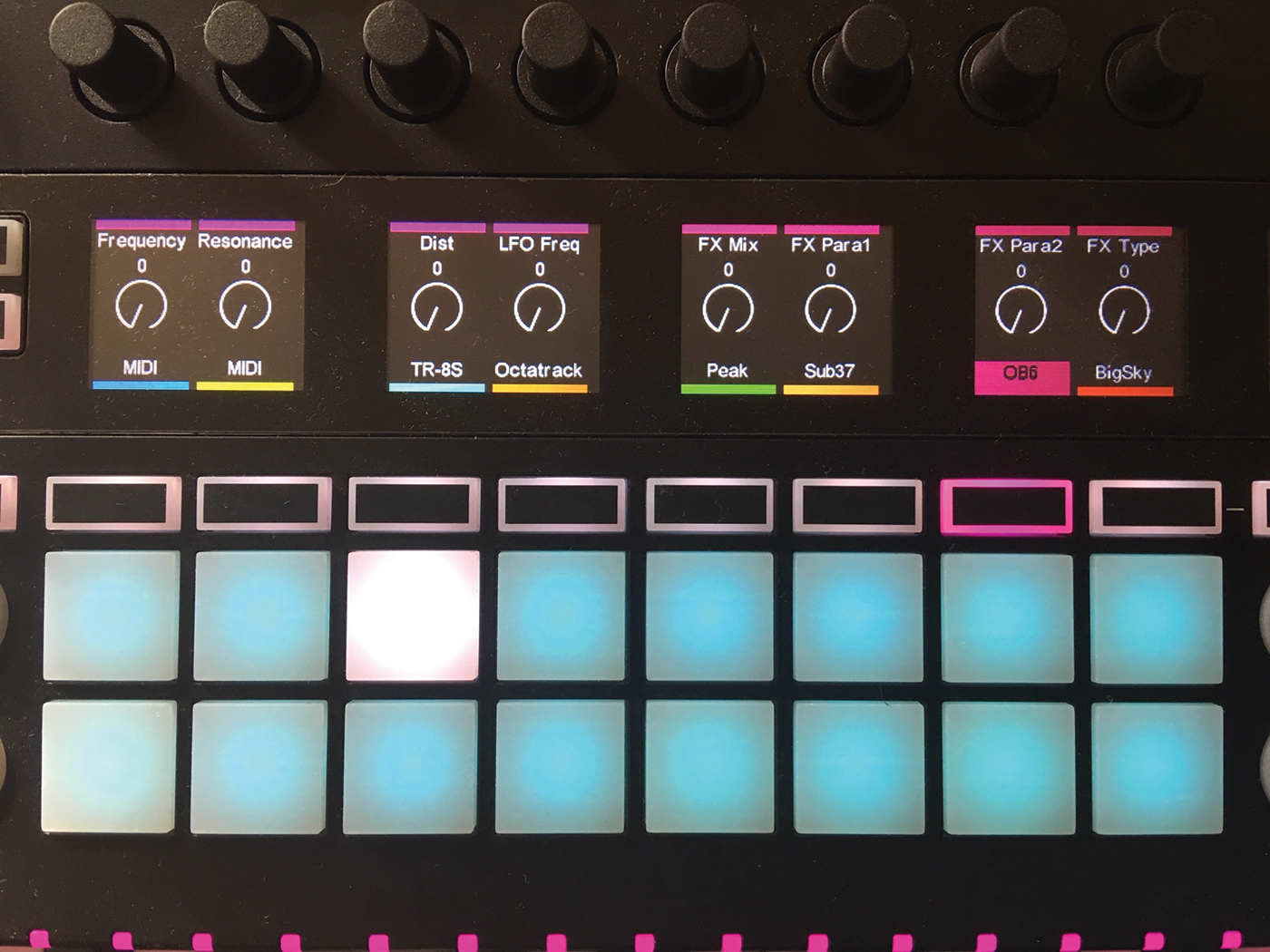
Use the on-board sequencer to record patterns via 16 pads, then switch to another Template (in this case a DSI OB6) to sequence that! Easy!
The sequencer
Now for the sequencer. Again, this is straight out of Circuit but it is eight parts in size, so everything I’m about to tell you can be applied to each of those eight parts or destinations. That means you can sequence up to eight different external destinations simultaneously with one clock to keep everything perfectly in sync.
The Sequencer breaks down into Step and Pattern Modes. In Step Mode you get a familiar cycling around 16 steps. Press play and each of the 16 pads lights up white as the sequencer cycles around. Press a pad and your note to record it; press the pad again and the note lights up red on the keyboard and press it to delete (or use the Clear button to the left). You can also simply record notes into a Pattern by playing them manually with the keyboard – simply hit the red Record button and play as it cycles.
This all becomes brilliant in operation when you want to edit note velocity, gate (length) or how the Pattern plays. Hit the Options key to access all of these. The first two screens show Velocity, Gate and Pattern options. You then hit the soft key beneath each and the screens show rotaries to adjust the velocities or step lengths to adjust the gate length on the pads/notes that have been recorded. I’m making it sound complicated but, trust me, it’s beautiful in operation.
The third option here, Pattern, simply lets you play around with how your sequenced pattern plays. You can randomise it, make it play backwards and adjust the start and stop position – pretty inspiring when you come up with something unexpected.
Patterns can be chained together or simply triggered manually in Patterns Mode which turns the 16 pads into Pattern triggers rather than individual note/steps. Here it’s very easy to get complete songs going as you can, for example, simply hold down two Pattern pads to chain them together.
Expand View shows the Patterns vertically in an 8×8 grid so you can quickly explore larger songs. I did get a little lost here at first as there is no indication – a pad colour change, for example – showing which slots contained recorded info.
I should also add with the sequencer that there is full automation available with up to eight controls – rotary pads and so on – can be recorded per track.
The best complement I can pay the Sequencer is that it is as easy to use as Circuit’s. Yet it can do so much more, especially when you start building music across its eight tracks, working with all that external hardware and software. Brilliant.
More control
I’ve banged on about the Sequencer and Templates a little too much but, in that, I’ve also shown how good SL MkIII controls and sequences external hardware, so now let’s look at how it works with your DAW. Here, select InControl and you should be on your way to ’seamless integration’ with Pro Tools, Cubase, Reaper, Logic, Reason and Live. When you first select it, it will be in HUI mode, that is the standard control mode that offers some control over certain DAWs including Cubase and Pro Tools. The manual gives a good rundown of how to set each up, but it’s pretty standard stuff.
The integration goes somewhat deeper with Ableton Live, the latest version (10.0.4) of which comes with an SL MkIII template and should auto set up. Once it does, and InControl picks up Live, it’s really something to behold. The screens list all the soft synths you have loaded in your Live tracks and set themselves up as those tracks. You can access soft synth parameters as you could with the hardware, via Templates.
The Pads play and mute each of the Clips and you navigate across your whole song set using up/down/left/right arrows on SL. The 16 pads are also velocity-sensitive and auto set up to play Live’s Drum Racks which is fantastic. Then you solo, mute and arm tracks with the buttons to the top right. It’s all quite amazing and the depth you can go to is something else!
In Logic I then tried an early beta template and had mute, solo, channel faders, and pans working no problem. Pressing the Options button and then Smart option, I was then given access to eight mappable controls on screen and was quickly controlling some of the main parameters on ES2, so this was a pretty fulsome experience all round.
Expect at least this native plug-in control with the newer Logic template that will be available by the time you read this. The same level will be offered with Reason but not the HUI-based DAWs which will require some MIDI learning, but plug-in control is very do-able with all DAWs apparently.
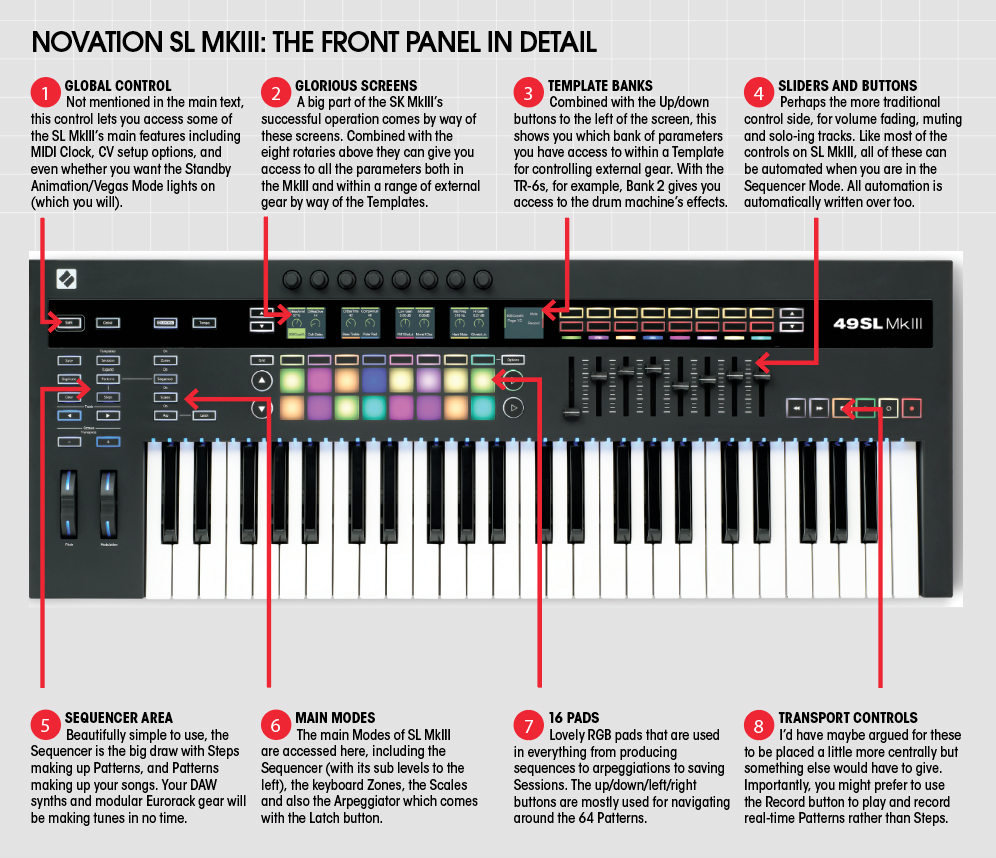
ARP, zones, scales & LED
I now quickly need to touch on the Arpeggiator, Scales and Zone features. The latter two, especially, are where the LED colours on the keyboard really come into play. Zones allows you to set up to eight different keyboard zones, shown on the keyboard in different colours. Set each Zone up with a different destination and you can then use the keyboard to play, for example, eight different external pieces of hardware at the same time.
Better still, bring the Sequencer in and record the drums from a Live Drum Rack and the bass from your soft synth, then branch back out and play hardware! Zones, combined with the Sequencer are the highlight features on the SL MkII – indeed a highlight in music technology! It’s where it comes together; what SL MkIII is all about: sequencing, controlling, hard and soft, and all with complete ease.
Next up, Scales lets you select a different scale from 16 different types (and, yes, Bebop Dorian is included, before you ask). Then you can select a root note and this is shown brightly lit on the keyboard, with all other notes in the scale dimly lit so you know which ones you can safely play – a very useful learning tool and there’s even a Filter which switches off ’wrong’ notes so you can’t play them!
The Arpeggiator is my last main focus. You can choose from seven different arpeggiator types with up to 16 notes cycling around the pads on the keyboard which can be muted and unmuted as it cycles. There are plenty of note editing options but, again, the best part here’s that you can send the arpeggiation to different destinations so if you have your eight parts set up to different pieces of hardware, you can try out an arpeggiation on each.
Sadly you can’t have different arpeggiations running simultaneously to different bits of gear, but you can have the same one triggering each synth which is very cool for auditioning. What you can also do, brilliantly, is then go into Scales and start playing perfectly in-tune chord progressions with arpeggiations in whatever scale you want. Instant trance Mixolydian-style!
Finally, phew, all Sessions – that is complete Sequences, Patterns and Template set-ups – can be saved on the keyboard or backed up to the Novation Components website where new Templates can also be created and sent to the keyboard.
Conclusion
Way back when I heard about SL MkIII, I thought I would focus on the software control side of SL MkIII as that is really where previous models in the SL range were focused, particularly with that AutoMap technology. However, what really comes out of this test is that SL MkIII is more about the hardware; well, more about your studio. Those Templates really do make controlling, sequencing and automating your studio a breeze, you might even – whisper – move away from your DAW and completely into the hard environment.
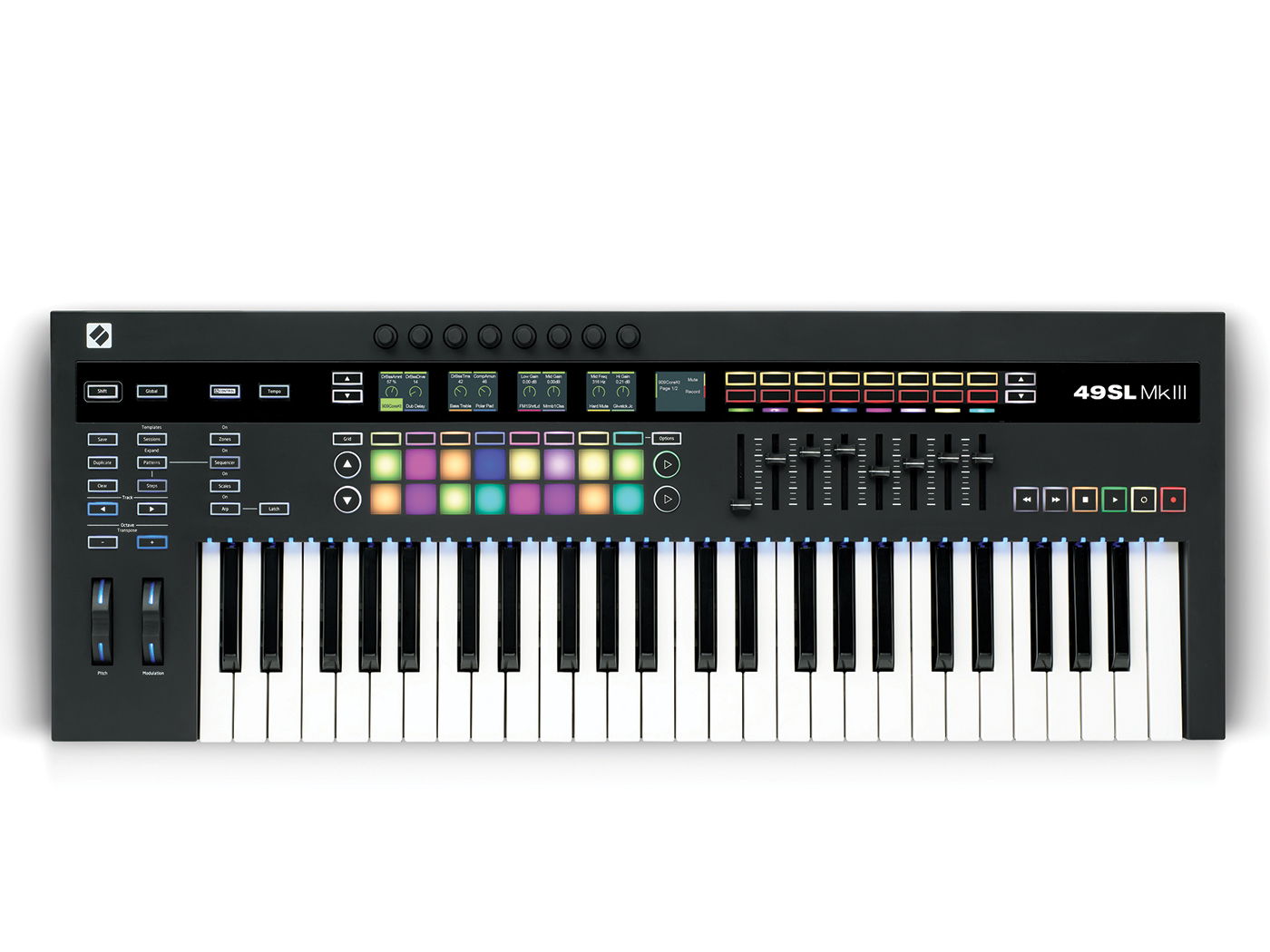
But I’m making that soft/hard distinction mistake again, because really the best thing I can say about SL MkIII is that it smashes those barriers down. Rather like Komplete Kontrol was a game-changer for making you turn away from your computer for controlling software, so SL MkIII is a game-changer for sequencing your hardware and software away from or, indeed with your computer! SL MkIII is genuinely the most exciting piece of tech I��’ve reviewed all year. Incredible.
Do I really need this?
Novation is aiming SL MkIII at three types of user: the DAW user who has one or two pieces of choice hardware, the studio owner who has a whole bunch of hardware synths, and the live player who needs to control a load of hardware synths and effects on stage. Are any of those people you? Of course, otherwise you wouldn’t be reading this magazine. So SL MkII clearly has your name on it, but whether you absolutely need it really depends, as always, on your current set-up and how pleased/pissed off you are with it.
If you are frustrated by how little your stuff gets on, how little your software seems to gel with a large hardware rig, then this could be the one ring to rule it all. And don’t forget the sequencer angle too. One annoyance I still have is booting up the computer when I have inspiration only for an annoying delay between interface and DAW ’talking’ to one another. The sequencer on this thing is instant and will get your ideas moving fast!
Alternatives
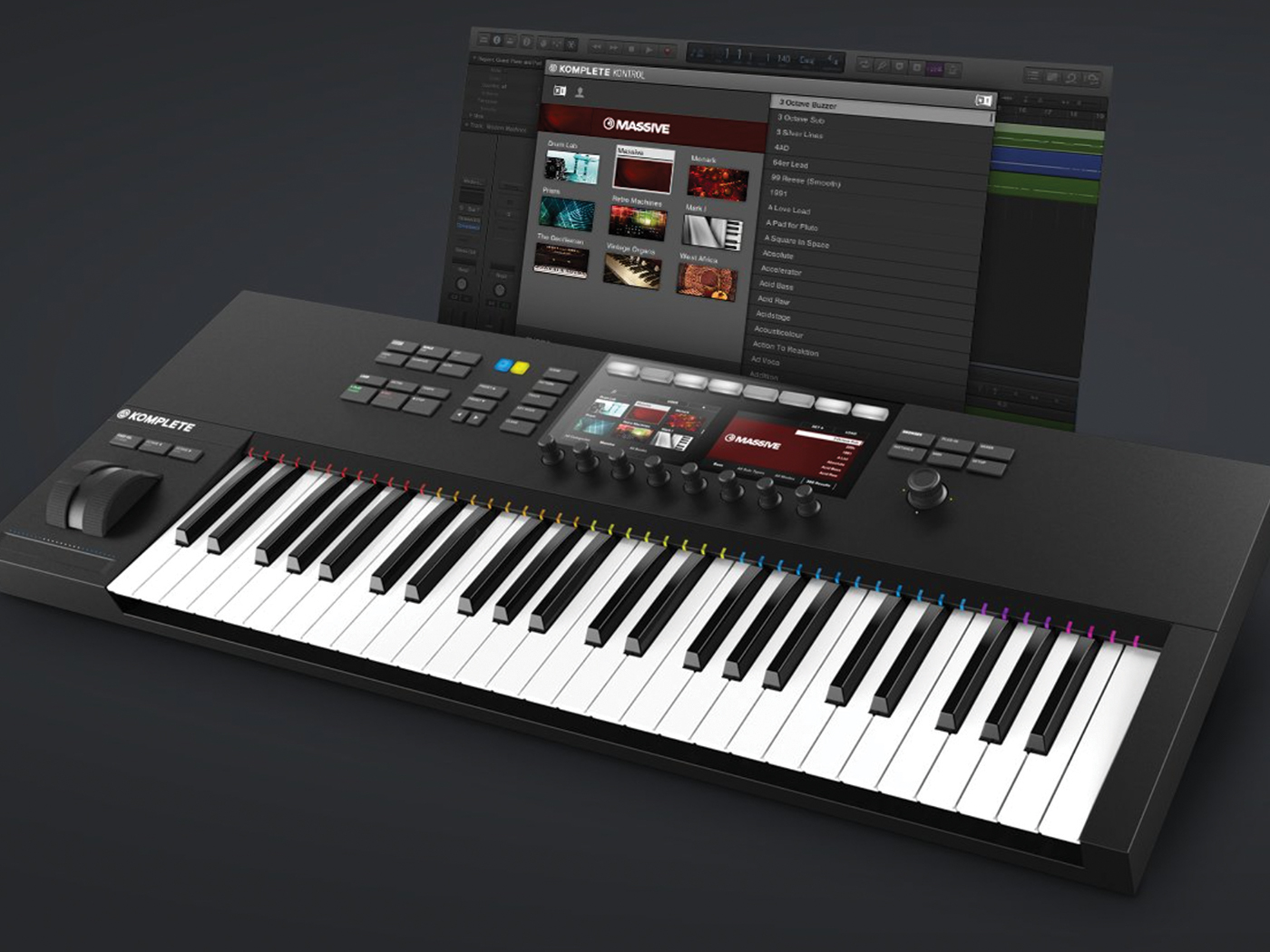
NI
Komplete Ultimate + Komplete Kontrol £800-£1,500
Now, despite both having lit keyboards, KK and SL MkIII are very different machines. Where SL focuses on studio templates, KK is more about software.
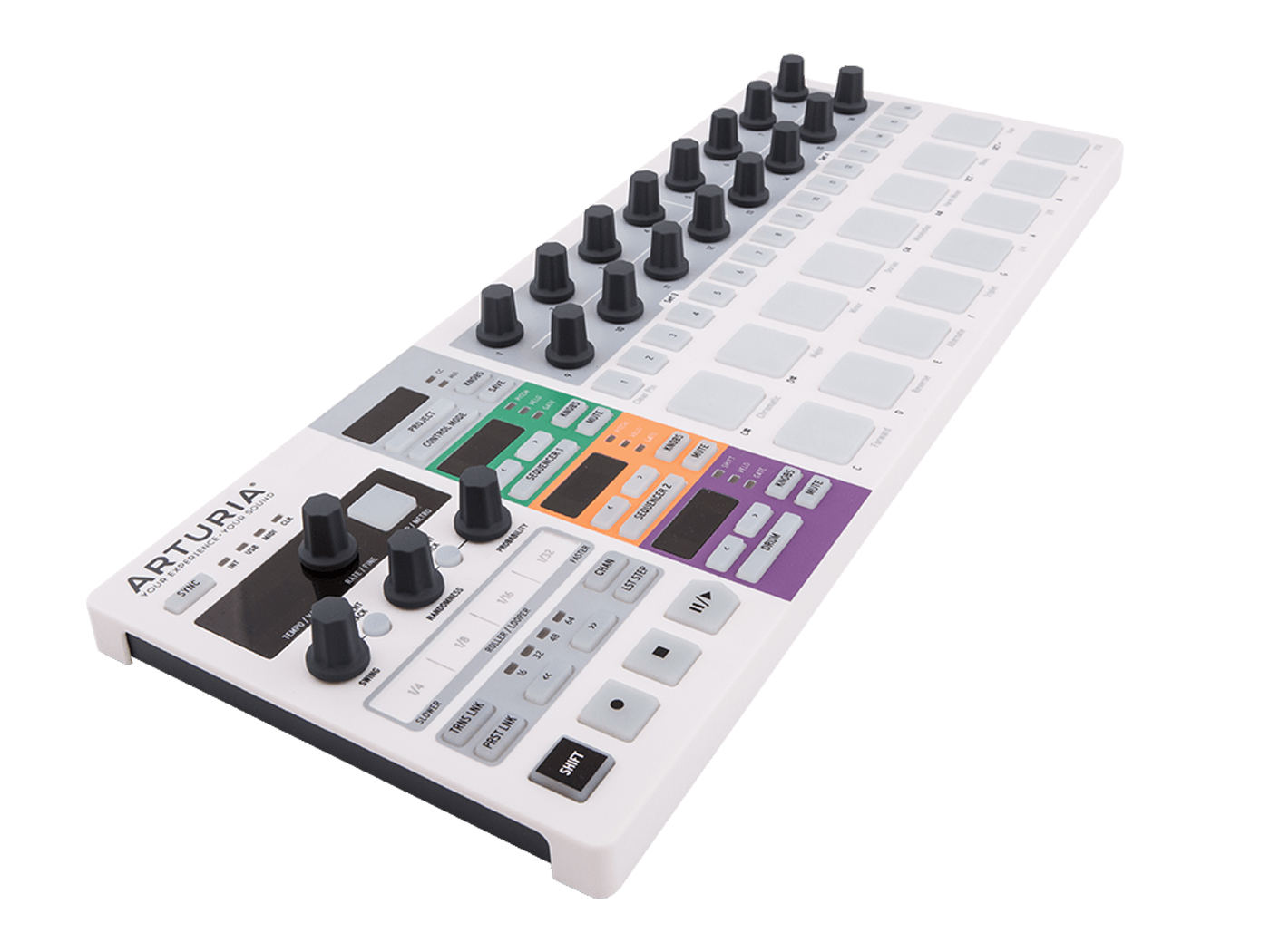
ArtUria
Beatstep Pro £225
Two channels of melodic sequencing, 8 channels of drum triggering, up to 64 steps. We said: ”that it will run seamlessly alongside your computer makes it a nice bridge between DAW and purposeful sequencing hardware.”